- Home
- Sherman Alexie
Indian Killer Page 3
Indian Killer Read online
Page 3
John never did become a good basketball player, but he graduated from high school on time, in 1987. Since he was an Indian with respectable grades, John would have been admitted into almost any public university had he bothered to fill out even one application. His parents pushed him to at least try a community or technical college, but John refused. During his freshman year in high school, John had read an article about a group of Mohawk Indian steel workers who helped build the World Trade Center buildings in New York City. Ever since then, John had dreamed about working on a skyscraper. He figured it was the Indian thing to do. Since Daniel Smith was an architect, he sometimes flattered himself by thinking that John’s interest in construction was somehow related. Despite John’s refusal to go to college, his parents still supported him in his decision, and were sitting in the third row as he walked across the stage at St. Francis to accept his diploma. Polite applause, a few loud cheers from his friends, his mother and father now standing. John flipped his tassel from one side to the other, blinked in the glare of the flashbulbs, and tried to smile. He had practiced his smile, knew it was going to be needed for this moment. He smiled. The cameras flashed. John was finished with high school and would never attend college. He walked offstage and stepped onto the fortieth floor of an unfinished office building in downtown Seattle.
John Smith was now twenty-seven years old. He was six feet, six inches tall and heavily muscled, a young construction worker perfect for all of the heavy lifting. His black hair was long and tucked under his hard hat. When he had first started working, his co-workers used to give him grief about his hair, but half of the crew had long hair these days. Seattle was becoming a city dominated by young white men with tiny ponytails. John always had the urge to carry a pair of scissors and snip off those ponytails at every opportunity. He hated those ponytails, but he did not let them distract him at work. He was a good worker, quiet and efficient. He was eating lunch alone on the fortieth floor when he heard the voices again.
John swallowed the last of his cold coffee and gently set the thermos down. He cupped his hand to his ear. He knew he was alone on this floor, but the voices were clear and precise. During the quiet times, he could hear the soft why-why-why as Father Duncan’s leather sandals brushed against the sand on his long walk through the desert. Once, just once, John had heard the bubble of the baptismal fountain as Father Duncan dipped him into the water. Sometimes there were sudden sirens and explosions, or the rumble of a large crowd in an empty room. John could remember when it first happened, this noise in his head. He was young, maybe ten years old, when he heard strange music. It happened as he ran from school, across the parking lot, toward the car where Olivia waited for him. He knew this music was written especially for him: violins, bass guitar, piano, harmonica, drums. Now, as he sat on the fortieth floor and listened to those voices, John felt a sharp pain in his lower back. His belly burned.
“Jesus,” said John as he stood up, waving his arms in the air.
“Hey, chief, what you doing? Trying to land a plane?”
The foreman was standing in the elevator a few feet away. John liked to eat his lunch near the elevator so he could move quickly and easily between floors. He always liked mobility.
“Well,” said the foreman. “What’s up?”
John lowered his arms.
“On my break,” John said. He could still hear voices speaking to him. They were so loud, but the foreman was oblivious. The foreman knew John always ate lunch alone, a strange one, that John. Never went for beers after work. Showed up five minutes early every day and left five minutes late. He could work on one little task all day, until it was done, and never complain. No one bothered him because he didn’t bother anyone. No one knew a damn thing about John, except that he worked hard, the ultimate compliment. Not that the hard work mattered anymore, since there would be no more high-rise work in Seattle after they finished this job. They were building the last skyscraper in Seattle. Computers had made the big buildings obsolete. No need to shove that many workers into such a small space. After this last building was complete, the foreman would take a job for the state. He did not know what John had planned.
“Well,” the foreman said. “Lunch is over. Get in. We need you down on thirty-three.”
John was embarrassed. He felt the heat build in his stomach, rise through his back, and fill his head. It started that way. The heat came first, followed quickly by the music. A slow hum. A quiet drum. Then a symphony crashing through his spinal column. The foreman brought the heat and music. John looked at him, a short white man with a protruding belly and big arms. An ugly man with a bulbous nose and weak chin, though his eyes were a striking blue.
John knew if he were a real Indian, he could have called the wind. He could have called a crosscutting wind that would’ve sliced through the fortieth floor, pulled the foreman out of the elevator, and sent him over the edge of the building. But he’s strong, that foreman, and he would catch himself. He’d be hanging from the edge by his fingertips.
In his head, John could see the foreman hanging from the fortieth floor.
“Help me!” the foreman would shout.
John saw himself plant his feet just inches from the edge, reach down, take the foreman’s wrists in his hands, and hold him away from the building. John and the foreman would sway back and forth like a pendulum. Back and forth, back and forth.
“Jesus!” the foreman would shout. “Pull me up!”
John would look down to see the foreman’s blue eyes wide with fear. That’s what I need to see, that’s what will feed me, thought John. Fear in blue eyes. He would hold onto the foreman as long as possible and stare down into those terrified blue eyes. Then he’d let him fall.
“Let’s go, chief,” the foreman said, loud and friendly. “We ain’t got all day. We need you on thirty-three.”
John stepped into the elevator. The foreman pulled the gate shut and pressed the button for the thirty-third floor. Neither talked on the way down. John could feel the tension in his stomach as the elevator made its short journey. He fought against the music.
“Chuck needs your help,” the foreman said when they arrived.
John looked where the foreman pointed. The thirty-third floor was a controlled mess. Chuck, a white man with a huge moustache, was pounding a nail into place. He raised a hammer and brought it down on the head of the nail. He raised the hammer, brought it down again. Metal against metal. John saw sparks. Sparks. Sparks. He rubbed his eyes. The sparks were large enough and of long enough duration to turn to flame. The foreman didn’t see it. The rest of the crew didn’t see it. Chuck raised the hammer again and paused at the top of his swing. As the hammer began its next descent, John could see it happening in segments, as in a series of still photographs. In that last frozen moment, in that brief instant before the hammer struck again its explosion of flame, John knew exactly what to do with his life.
John needed to kill a white man.
3
Owl Dancing at the Beginning of the End of the World
JOHN SAT ALONE ON the fortieth floor. He could see a white man working at a small desk in an office across the street. A small man from any distance. John knew he could kill a white man, but he was not sure which white man was responsible for everything that had gone wrong. He thought hard that day, could barely work, and often stared off into space, trying to decide. Which white man had done the most harm to the world? Was it the richest white man? Was it the poorest white man? John believed that both the richest and poorest white men in the country lived in Seattle.
The richest man owned a toy company. No. He owned the largest toy company in the world. It had thousands of employees. John saw the rich man on television. In commercials. On talk shows. On goofy game shows. His wedding was broadcast nationally. He had married a movie star, one of those beautiful actresses whose name John always forgot. Julie, Jennifer, Janine. The rich man’s name was short and masculine, a three-lettered name that was somehow smaller and still mo
re important than John. Bob or Ted or Dan or something like that. A monosyllabic, triangular monument of a name. A name where every letter loudly shouted its meaning. John could not understand how a man named Bob or Ted became rich and famous by selling toys. How can a toy maker meet and marry a beautiful actress? John knew that Bob or Dan must have sold his soul, that slaves worked in his factories. Thousands of children. No. Indians. Thousands of Indians chained together in basements, sweating over stupid board games that were thinly disguised imitations of Scrabble and Monopoly, cheap stuffed monkeys, and primitive computer games where all the illegal space aliens were blasted into pieces. But John could not convince himself that the richest man in the world deserved to die. It was too easy. If he killed the richest white man in the world, then the second-richest white man would take his place. Nobody would even notice the difference. All the money would be switched from one account to another. All the slaves would stop making toys, move to another factory, and begin making car alarms, director’s chairs, or toasters. John could kill a thousand rich white men and not change a thing.
The poorest white man in the world stole aluminum cans from John’s garbage. Well, that was not exactly true. Every Monday, John set the cans outside his apartment building for the recycling truck to collect, but the poorest white man always arrived first. John watched him from his bedroom window. The poorest white man dressed in ragged clothes. His skin diseased, face deeply pockmarked, hair pulled back in a greasy ponytail. The poor man would pick up the aluminum cans one by one and drop them into his shopping cart. Empty Campbell’s tomato soup cans, Pepsi cans, cans that once held stew or creamed corn, hash or pineapple chunks. One by one, carefully, as if the aluminum cans were fragile, priceless. John hoped the poorest white man sold the cans for cents on the pound, and then bought some food. The poorest man might have a family, a white wife, white kids, all starving in some city park. But John knew the poorest man sold the cans for booze money. He just drank and drank. Fortified wine, rubbing alcohol, Sterno. John hated poor white men, but he knew killing them was a waste. They were already dead. They were zombies. John could stick a bomb in one of his aluminum cans. A mercury switch. When the zombie picked up the can, the switch would move, and boom! But it would be a small gesture, little more than waving good-bye to someone you had just met.
Rich man, poor man, beggarman, thief. Lawyer, doctor, architect, construction foreman. John knew this was the most important decision in his life. Which white man had done the most harm to Indians? He knew that priests had cut out the tongues of Indians who continued to speak their tribal languages. He had seen it happen. He had gathered the tongues in his backpack and buried them in the foundation of a bank building. He had held wakes and tried to sing like Indians sing for the dead. But Father Duncan was proof of something bigger, wasn’t he? Father Duncan, an Indian, had walked into the desert like a holy man and disappeared. Whenever he closed his eyes, John could see the desert. The cacti, lizards, washes, and sand dunes, the lack of water. John knew what water meant to life. A man could have a camel loaded down with food, enough for weeks, but that same man would die without water. A man without water could last for two days, three days, four days at most. Father Duncan did not take any water into the desert with him. He left behind his paints and an empty canvas. He left behind his hat and shoes. But there was no water in the desert, not for miles and miles. How could Father Duncan have survived such a journey? How was he saved? How had he arrived in John’s dreams, both awake and asleep? John could see the stand of palm trees at the horizon, either an illusion or a place of safety. Could see Duncan in his black robe staggering across the hot sand. If John concentrated hard, he could see Father Duncan’s red-rimmed eyes, cracked lips, burned skin. So much thirst.
After quitting time, John rode the elevator down through the unfinished building. He rode with the foreman and a couple other co-workers named Jim and Jerry. Nobody knew the foreman’s name. He was simply known as the foreman. John knew these white men were mostly harmless and would live forever. They would leave work and have a few beers at the same tavern where they had been drinking together for years. They were regulars. Jim, Jerry, and the foreman would walk into the bar and all the patrons would loudly greet their arrival.
John stepped off the elevator, ignored offers to go for beers, and walked through the downtown Seattle streets. There were so many white men to choose from. Everybody was a white man in downtown Seattle. The heat and noise in his head were loud and painful. He wanted to run. He even started to run. But he stopped. He could not run. Everybody would notice. Everybody would know that he was thinking about killing white men. The police would come. John breathed deeply and started to walk slowly. He was walking in work boots and flannel shirt through Seattle, where men in work boots and flannel shirts were often seen walking. No one even noticed John. That is to say that a few people looked up from their books and a couple drivers looked away from the street long enough to notice John, then turned back to their novels and windshields. “There’s an Indian walking,” they said to themselves or companions, though Indians were often seen walking in downtown Seattle. John the Indian was walking and his audience was briefly interested, because Indians were briefly interesting. White people no longer feared Indians. Somehow, near the end of the twentieth century, Indians had become invisible, docile. John wanted to change that. He wanted to see fear in every pair of blue eyes. As John walked, his long, black hair was swept back by the same wind that watered his eyes. He walked north along the water, across the University Bridge, then east along the Burke-Gilman Trail until he was standing in a field of grass. He had made it to the wilderness. He was free. He could hunt and trap like a real Indian and grow his hair until it dragged along the ground. No. It was a manicured lawn on the University of Washington campus, and John could hear drums. He had been on the campus a few times before but had never heard drums there. He walked toward the source of the drums. At first, he thought it was Father Duncan. He was not sure why Father Duncan would be playing drums. Then he saw a crowd of Indians gathered outside a large auditorium, Hec Edmundson Pavilion. There were two drums, a few singers and dancers, and dozens of Indians watching the action. So many Indians in one place. There were white people watching, too, but John turned away from their faces. He stepped into the crowd, wanting to disappear into it. A small Indian woman was standing in front of John. She smiled.
“Hey,” she said.
“Hey,” he said.
“I’m Marie. Are you a new student here?”
“No.”
“Oh,” she said, disappointed. She was the activities coordinator for the Native American Students Alliance at the University and thought she’d found a recruit. A potential friendship or possible romance.
“What’s your name?”
“John.”
“What tribe you are?”
He could not, would not, tell her he had been adopted as a newborn by a white couple who could not have children of their own. Along with the clipping about Father Duncan’s disappearance, John always carried the photograph of the day his parents had picked him up from the adoption agency. In the photograph, his father’s left arm is draped carefully over his mother’s shoulders, while she holds John tightly to her dry right breast. Both wear expensive, tasteful clothes. John had no idea who had taken the picture.
His adopted parents had never told him what kind of Indian he was. They did not know. They never told him anything at all about his natural parents, other than his birth mother’s age, which was fourteen. John only knew that he was Indian in the most generic sense. Black hair, brown skin and eyes, high cheekbones, the prominent nose. Tall and muscular, he looked like some cinematic warrior, and constantly intimidated people with his presence. When asked by white people, he said he was Sioux, because that was what they wanted him to be. When asked by Indian people, he said he was Navajo, because that was what he wanted to be.
“I’m Navajo,” he said to Marie.
“Oh,” she
said, “I’m Spokane.”
“Father Duncan,” said John, thinking instantly of the Spokane Indian Jesuit.
“What?”
“Father Duncan was Spokane.”
“Father Duncan?” asked Marie, trying to attach significance to the name, then remembering the brief fragment of a story her parents had told her. “Oh, you mean that one who disappeared, right?”
John nodded his head. Marie was the first person he’d met, besides the Jesuits at St. Francis, who knew about Father Duncan. John trembled.
“Did you know him?” asked Marie.
“He baptized me,” said John. “He used to visit me. Then he disappeared.”
“I’m sorry,” said Marie, who was definitely not Christian. With disgust, she remembered when the Spokane Indian Assembly of God Church held a book burning on the reservation and reduced Catcher in the Rye, along with dozens of other books, to ash.
“I know a Hopi,” said Marie, trying to change the subject. “Guy named Buddy who works at the U. He’s a history teacher. Do you know him?”
“No.”
“Oh, I thought you might. He hangs around with the Navajo bunch. Jeez, but they tease him something awful, too.”

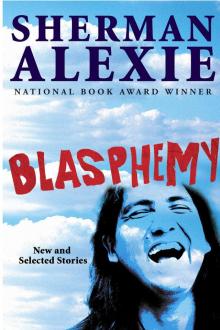 Blasphemy: New and Selected Stories
Blasphemy: New and Selected Stories The Absolutely True Diary of a Part-Time Indian
The Absolutely True Diary of a Part-Time Indian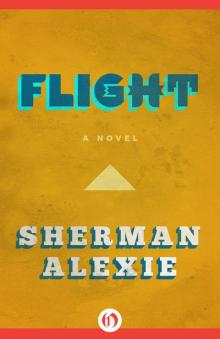 Flight
Flight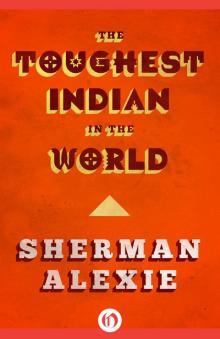 The Toughest Indian in the World: Stories
The Toughest Indian in the World: Stories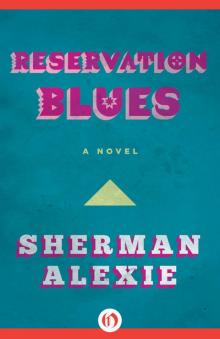 Reservation Blues
Reservation Blues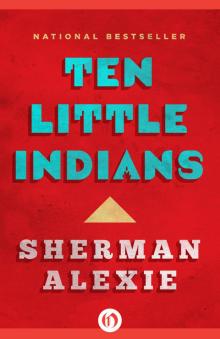 Ten Little Indians: Stories
Ten Little Indians: Stories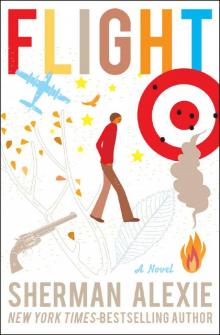 Flight: A Novel
Flight: A Novel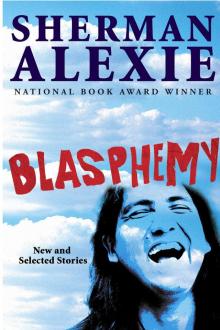 Blasphemy
Blasphemy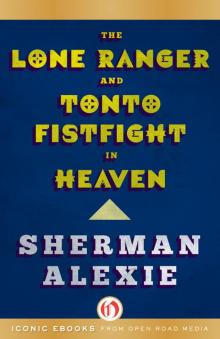 The Lone Ranger and Tonto Fistfight in Heaven
The Lone Ranger and Tonto Fistfight in Heaven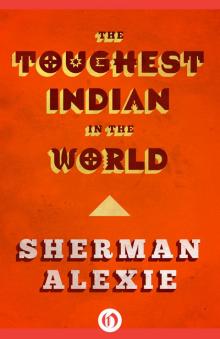 The Toughest Indian in the World
The Toughest Indian in the World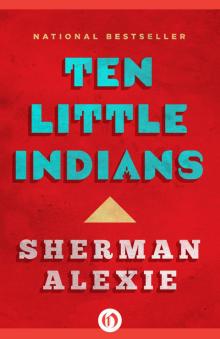 Ten Little Indians
Ten Little Indians